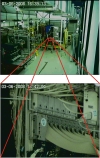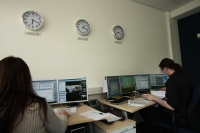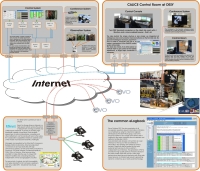 |
 |
|||||||||||||
|
|||||||||||||
|
|||||||||||||
|
Even if you don't want to step through new control room's swish sliding doors, you can have a look inside DESY's new feature because of its doors made of glass: it is a medium-sized room with some technical interior and an ILC colour scheme. There are two computer working stations, each with four monitors and a small conference table; on a big screen you see the pictures from three webcams; and three clocks hang on the wall, showing the local times of DESY/CERN in Hamburg/Geneva, Fermilab near Chicago and KEK near Tokyo.
“Everyone, who passes the room can see what is going on in there. That gives transparency,” says Sven Karstensen (DESY). This is one part of the idea of the new remote control system, used at the moment by CALICE (CAlorimeter for the LInear Collider Experiment), connecting the CALICE experiment at Fermilab with the new control room at DESY. Since beginning of May the calorimeters of the CALICE collaboration are placed at Fermilab's Meson Test Beam Facility to run for the next year. And since mid-May the control room is open at DESY. From there the scientists in Hamburg can now steer the CALICE experiment and monitor the data taking half a world away. Besides the controlling, they can analyse the data of the three detector parts ECal, HCal and Tailcatcher online. And with an installed conference system including a visual connection with webcams and an acoustical one via Voice-over-IP the scientists can work together as though they were in the same room. “Yesterday the stage of the experiment didn't move. So we searched the problem together - my colleagues at the experiment in Chicago and me in Hamburg. In the end we found out that it was only a broken cable connection,” says Karstensen and laughs. With the webcams he can zoom into and out of the experimental setup, so he can observe even the smallest details at the experiment.
Besides the transparency of the room, which also gives a space for local scientists to come together and to discuss their work, a second important part of the idea of the new remote control system is availability. The new system allows every member of the CALICE collaboration to use the remote control at any time from every place - given that he has a computer with internet access and a Java-enabled browser. “At the time when the stage didn't work, I was at home, solving the problem with my laptop and webcam,” says Karstensen. “The fact that the complete system is based on the web is one of the innovations of this control system. Former systems had special technical equipment, which was a natural limitation of usage,” explains Karstensen. As a globally operating group, the collaboration of CALICE required an easy way to connect their 220 members worldwide. And so Karstensen and his team developed a remote system to give every member “flexibility to control their facilities, provide assistance and intervene in case of problems.” Another important component of the system and for scientists is a web-based logbook. The group MCS4 (Machine Control System, Group 4) at DESY developed the eLogbook, which documents every proceeding on the experiment. Every researcher who is logged in the remote system can see past events and comments of his colleagues. Directly editing and adding comments inside a browser window is just like sending entries to the eLog by mail. The other innovation of this system is the easy way to install it. “The communication parts can be installed by an experienced person within two weeks,” says Karstensen. He started thinking about such a system four years ago in the context of the Global Accelerator Network project. Now he is happy that his team installed a system which really works for instance for the CALICE experiment: “This control system is nearly perfect and the basic equipment does not cost more than approximately 7000 Euros.” The room at DESY was funded through a special Helmholtz Association grant and the Helmholtz Alliance 'Physics at the Terascale'. Needless to say, the control room and system can be used by other projects and collaborations as well. -- Jan Dreyling-Eschweiler (DESY) |
|||||||||||||
| © International Linear Collider |


